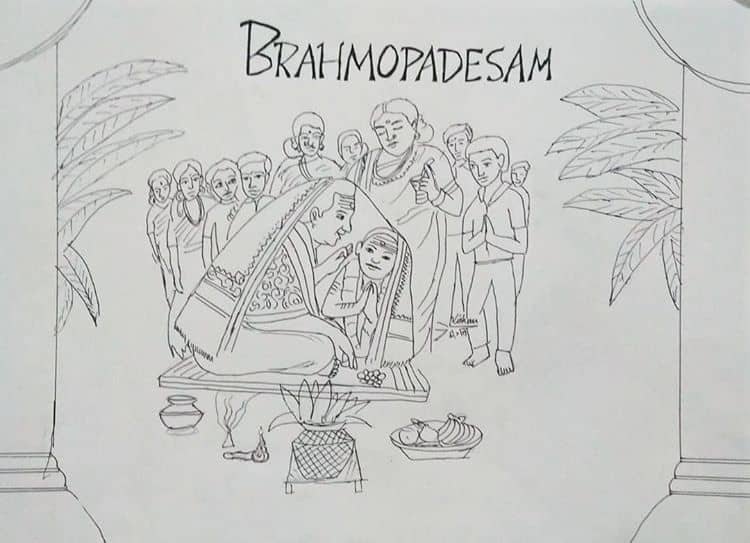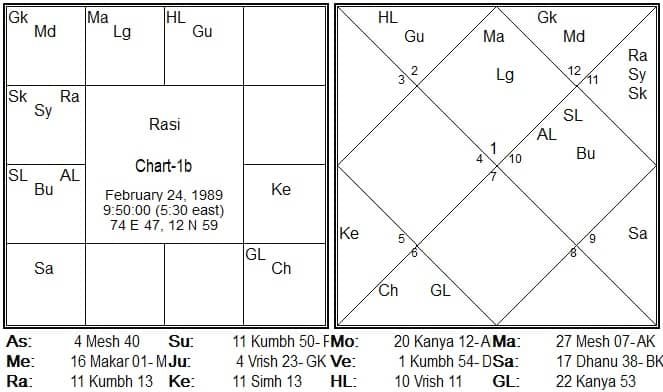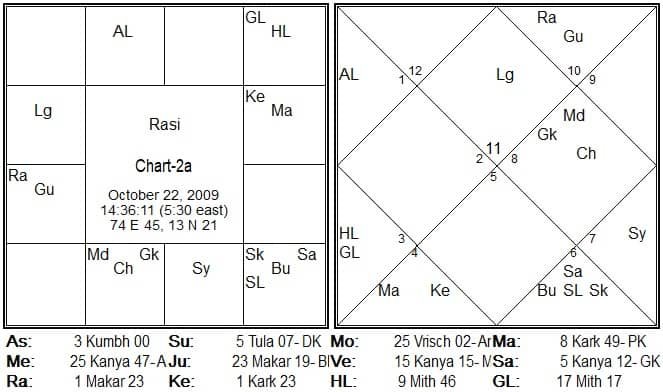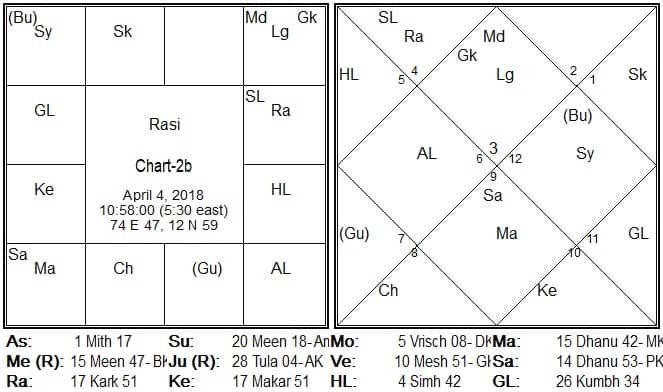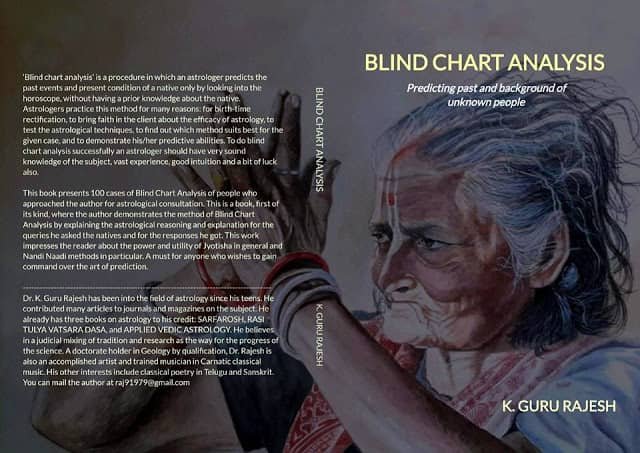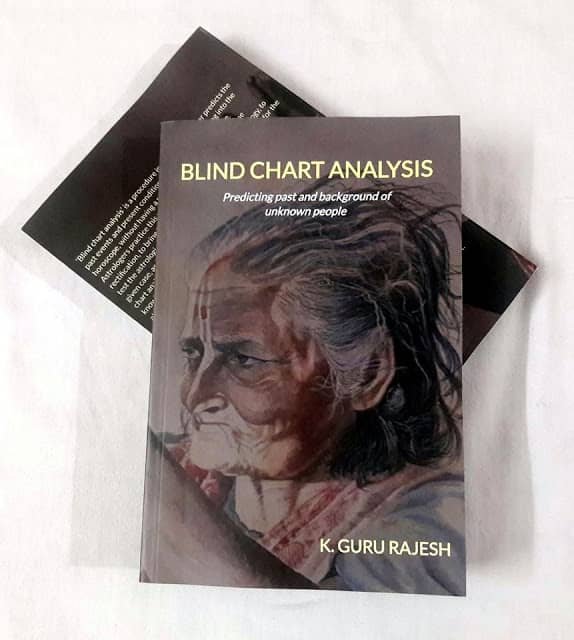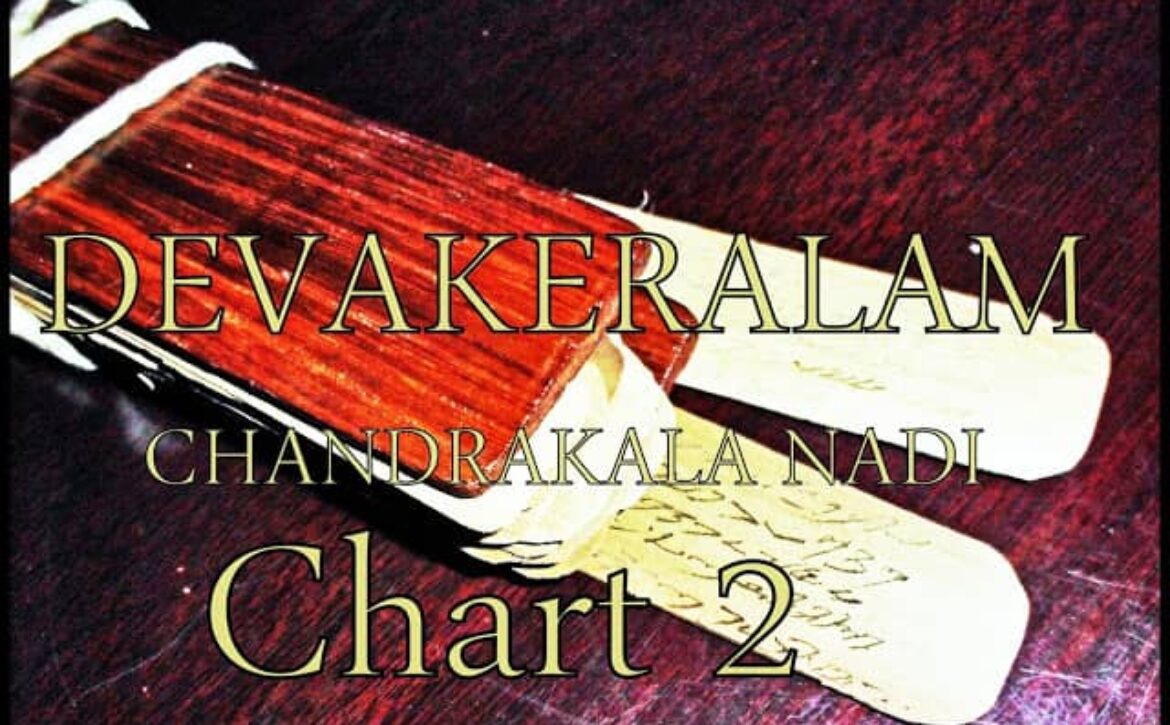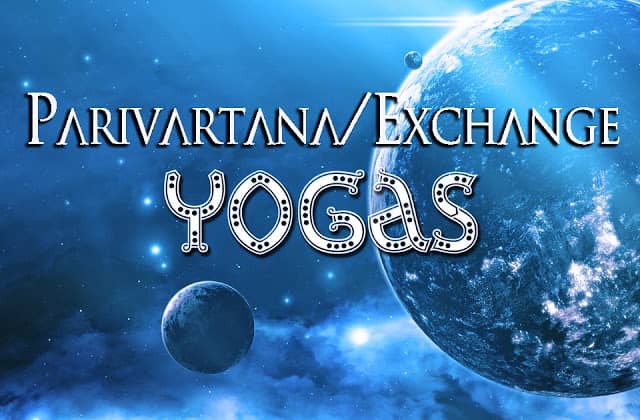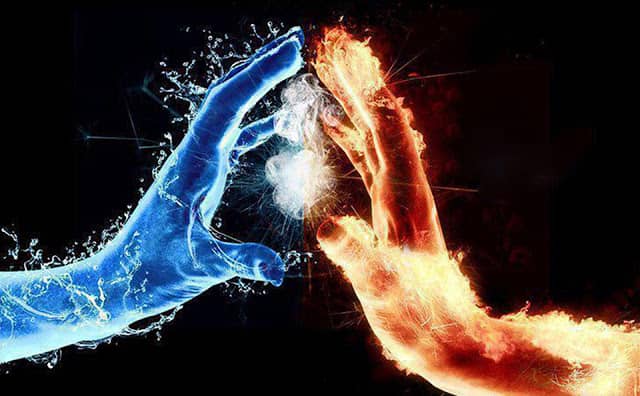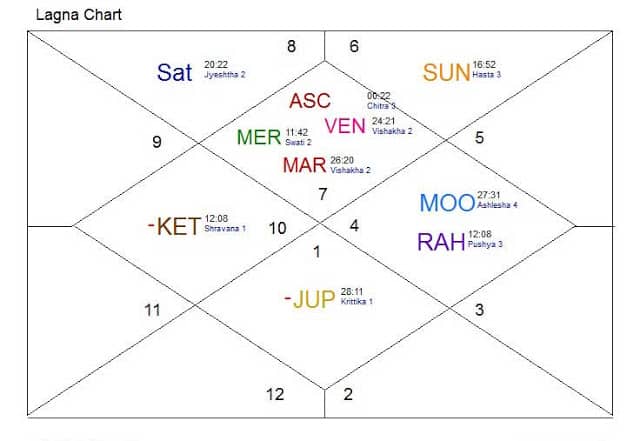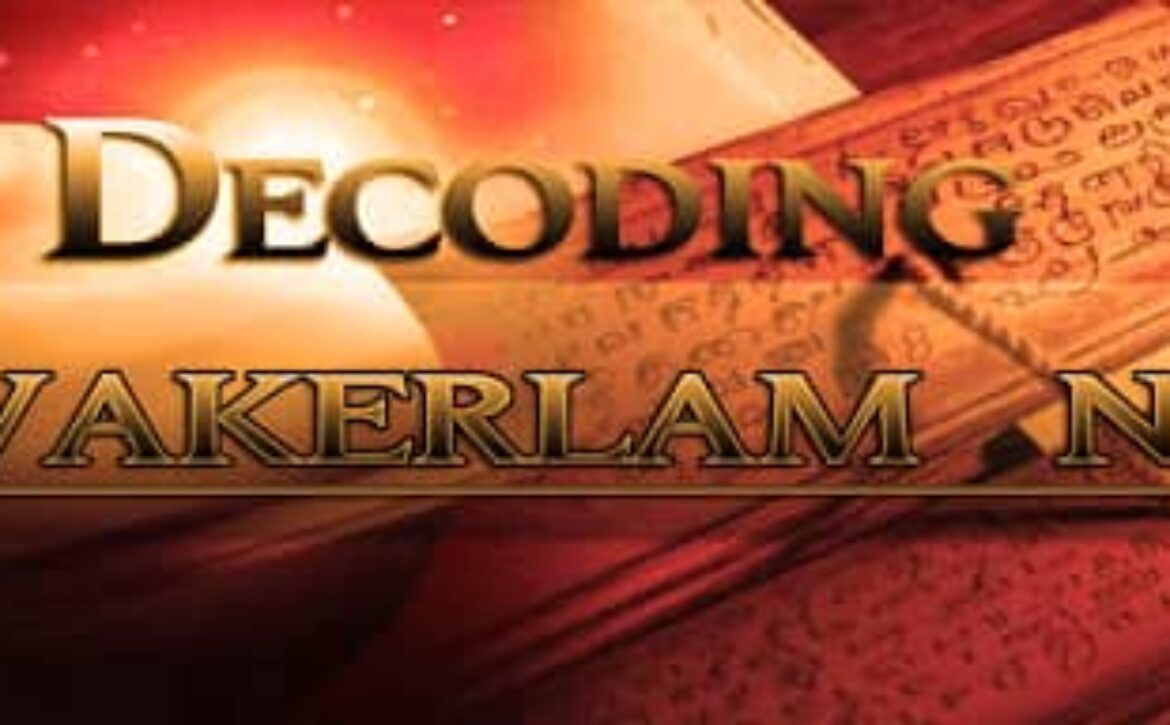Decoding Devakeralam
By Dr. K. Guru Rajesh
Glimpses of Jyotisha Techniques
Devakeralam or Chandra Kala Nadi authored by Achyuta and Venkatesa is a voluminous work extending to more than 9000 Slokas in two volumes and belongs to the category of Nadi literature in Vedic astrology. Though its original manuscript is with Government Oriental Manuscript Library, Chennai, which published it in 1950, the richness of its astrological knowledge was first introduced to the English readers by the late C.S. Patel. Later, the late R. Santhanam published the entire Sanskrit text with English translation. With due respect to these late scholars, I proceed to present before the esteemed readers the results of my own study of this great work.
Apparently, both Sri Patel and Sri Santhanam had assumed that Devakeralam does not deal with actual horoscopes, unlike other Nadi works, because the work uses Nadiamsas. “Nadi texts are of two kinds. One uses a certain starting point, known as particular Nadiamsa, which rises in the eastern horizon at birth e.g. Vasudha, Vaishnavi, Brahmi etc; while the other one deals with the actual horoscopes; showing all planetary positions and giving entire life histories of natives. The present chapter deals with the former one … ” says C.S. Patel in the 9th Chapter of his book Nadi Astrology. Santhanam also writes in the preface to his English translation of Devakeralam, “He (Achyuta) had also quoted Garga, Vasishta, Parasara, Yavana etc … These Nadis, unlike Saptharishi apparently contained principles usable in predictive astrology and not full-fledged horoscopes … “. Anyone going through the works of these scholars on Devakeralam can observe that this assumption was always there at the back of their mind. While Patel culled out and presented the general rules quoted in the work, the entire English translation of Santhanam is influenced by the above idea. This resulted in missing the spirit of the general rules at some places and in a mostly redundant English translation. Added to this, the poor editing of the original Sanskrit text at places made the English translation erroneous at those places.
A deep and repeated study of Devakeralam has revealed to me that the text, in fact, deals with actual horoscopes that can be constructed by the hints that are intelligently embedded within the text. The horoscope including Rasi and Navamsa positions of planets that are mentioned in the discussion and the birth star with its Pada can be known, from which the entire discussion becomes meaningful and instructive. All the general principles enumerated are demonstrated by the horoscope. Encouraged by this discovery, I started grouping the entire text in terms of different charts and started the further intensive study.
Based on Nadiamsas
There is an element in Devakeralam which is discouraging to serious astrologers. It is the fact of the text being based primarily on Nadi Amsas which are very minute 150th parts of a sign. Added to this, the text divides each Nadiamsa into two parts, Purvamsa and Uttaramsa, and further into four parts, each pertaining to the four Varnas. Given the problem of correct birth time recording and the controversies shrouding the Ayanamsa, practical minded people shun studying and applying Devakeralam. Nevertheless, I found that, besides the Nadiamsas, more than 60% of the text actually uses conventional astrological principles which can be grouped under the following heads.
Bhava and Yoga Analysis: Great insights can be obtained by studying the way Devakeralam analyses a Bhava using various parameters like Rasi, Navamsa, Arudha, Ashtakavarga etc. Different types of Yogas, both famous and not so well-known, can be learnt from the work. Cancellations of various benefic and malefic Yogas find a place here, which is rare to find in other classical texts. Predictions regarding different relatives of the native, even the distant ones like cousins, their spouses and children are also made in the work.
Use of Vargas: Devakeralam extensively uses the Navamsa position of planets in the analysis of Bhavas, Yogas and effects of Dasas. Besides Navamsa, other Vargas like Dwadasamsa, Trimsamsa and Shastyamsa have also been applied.
Use of Arudha: The text demonstrates the way to use Arudha Padas in Bhava analysis and also Dasa predictions. At several places, Arudha and Ashtakavarga are used in tandem.
Use of Ashtakavarga: Ashtakavarga usage has been demonstrated at several places to quantify the things to predict. The number of siblings of the parents, of the native etc., is predicted using prediction principles of ashtakavarga. Further, the age that may prove dangerous to the native as also the age from which the native’s life becomes productive can be known by these principles.
Use of Dasas: It uses Vimshottari Dasa mainly to predict the unfolding of the events in the native’s life. Kala Chakra Dasa also finds extensive usage in most of the horoscopes discussed. Besides this, a few horoscopes have been explained using Rasi Dasas, mostly Chara Dasa.
Use of Transits: Transits of Saturn and Jupiter find wide usage in timing of various good and bad events. The Navamsa positions of planets are extensively considered here. Transit analysis is used along with the Dasas to pinpoint the event.
Mundane and Political Predictions: Interestingly, Devakeralam demonstrates the way to predict mundane and political events from an individual’s horoscope which include death or defeat of the rulers, revolutions, famines, wars etc. Saturn’s transit in various signs has been used independently to predict troubles in various parts of southern India.
Remedies: The text is replete with remedial measures to ward off the evil results of planetary afflictions. They seem to be culled from authentic Smriti and Mantra Sastra works and are of great practical use.
Miscellaneous: The text also includes a variety of information on the usage of Rashmis; prediction of Janma Rasi and Lagna (Ascendant) of the spouse, children, employer etc; prenatal epoch and mentioning of various planetary Nadis from which additional information has been solicited.
The entire text of Devakeralam deals with actual horoscopes. I have given some of the horoscopes discussed, highlighting the conventional tools of astrology employed in their analysis.
The chart I is given under Slokas 188 to 367 in Volume 1. The birth start is Poorvashada 2nd quarter and the birth Dasa will be of Venus. The following are some of the points discussed in the text with regard to Chart 1.
(i) The Ascendant lord Jupiter is with 8th lord Moon in the Ascendant and receives the aspect of Mars, a natural malefic. The text says that Jupiter having 5 bindus in his Ashtakavarga, joining the 8th lord and aspected by malefic Mars will cause great danger to the life of the child at the age of 5 years (Sloka 196).
(ii) The Moon placed in Sagittarius Rasi and Virgo Navamsa makes Aquarius as the Deha-Rasi and Virgo as the Jeeva-Rasi as per Kala Chakra Dasa system (Sloka 320). (Because of poor editing, the word deha is printed as dvesha whose consequence can be noted in the accompanying English translation). The presence of Rahu in Virgo (and Saturn in Aquarius) at the time of birth indicates that the native will almost die in the very first year of his birth but will recover and survive (Sloka 321).
(iii) Whenever the junction between two signs of Kala Chakra Dasa or two Dasas of Vimshottari coincide with the transit of Saturn in the Jeeva-Rasi, the native will experience a lot of trouble in his life including unfortunate events to his kin. When the Libra Chakra Dasa ends and Scorpio Chakra Dasa starts for the present native which coincides with the transit of Saturn from Virgo, the Jeeva-Rasi, into Libra, he will experience very bad times like untimely death (Apamrutyu). This happens from the 19th year to the 21st year of the native. As a remedy he should give an image of the Zodiac in donation (Slokas 322-326).
(iv) Saturn being the lord of Bhagyarudha (Arudha of 9th house) placed in own sign and obtaining Capricorn Navamsa indicates that the native’s father will be of angry disposition inwards, pleasing in appearance and a miser (Sloka 267, 268). The Sun, the lord of the 9th house, is in Taurus, the 10th from Leo. Counting 10 signs from Taurus comes to Aquarius where Saturn is his placed in own sign.
(v) Saturn placed in Aquarius obtaining Capricorn Navamsa (Makaramsayute Mande wrongly typed as Makaramsekujemande in Sanskrit) and Venus placed in Pisces obtaining Aquarius Navamsa indicates obstructions in the native’s marriage. For any person born in any Nadiamsa, Saturn in the 3rd creates hurdles whenever marriage efforts are made. After failure of two or three attempts, the native will get married (Slokas 219-221). Jupiter obtaining the Navamsa of Mercury (Budhamsa wrongly typed as Brahmamsa in Sanskrit) and Venus obtaining Aquarius Navamsa indicates that the native will marry a girl in his birth place and she will be hailing from the North direction. The Ascendant lord Jupiter in Gemini, the 7th sign from the Rasi Ascendant and Karaka Venus in a fixed Navamsa indicates a wife from the birth place while Venus placed in Pisces indicates a wife from North direction.
(vi) The 8th lord Moon joining the Ascendant lord Jupiter indicates that the native will be fortunate in the Vipat Dasa (third Dasa from birth – that is Moon Dasa). The native will have Raja Yoga during this period enjoying conveyances, ornaments, prominent position in society and a lot of wealth. He will beget children in this Dasa and his own sister will also prosper (Slokas 240-241).
(vii) When Saturn in transit moves into Sagittarius and obtains Virgo Navamsa, death of the native’s mother is to be predicted. Otherwise, she may die when transiting Saturn aspects the 11th house, the 8th from the 4th house. Similarly, transit Saturn moving in Taurus and obtaining Aries Navamsa may kill the native’s father. This event may also happen when transit Saturn moves in trines to the sign occupies by the Sun in Navamsa (Slokas 300- 301). Note that Matrukaraka Moon occupies Sagittarius sign and Virgo Navamsa while Pitrukaraka Sun occupies Taurus sign and Aries Navamsa.
(viii) The native will have a lifespan that will end during the Dasa of the Ascendant lord Jupiter and Bhukti of 8th lord Moon (Sloka 258). During the Dasa of Aries of Kala Chakra Dasa which coincides with the Jupiter Vimshottari Dasa, the transit of Saturn in Aries will precipitate the death of the native in the solar months of Sagittarius or Gemini or Virgo (Slokas 362-63). Note that these three signs are influenced by the 8th lord Moon in Rasi and Navamsa.
Chart 2 comes under Slokas 548 to 637 in Volume I. The birth star of the native is Revati 3rd quarter and the birth Dasa will be of Mercury. The following are some of the points discussed in the text about the horoscope.
(i) The Ascendant lord Saturn obtaining a movable Navamsa and joined by Mars results in some physical deformity for the native’s mother or his elder sister (Sloka 548). Note that Mars is the 4th and 11th Lord.
(ii) The 9th Lord Mercury occupying Gemini Navamsa while Rahu is in the 9th house receiving the aspect of the Moon indicates that the native’s sister will be involved with a paramour (Sloka 551). Note that 9th house is the 7th house from the 3rd house.
(iii) When the Ascendant falls in Capricorn obtaining Leo Navamsa, while Ascendant lord joins the 4th lord Mars (kujasamyute wrongly typed as guru samyute in Sanskrit), the native’s mother will be ugly in appearance and wicked in nature and she does not heed her husband (Sloka 552).
(iv) When the Arudha of the 4th house falls in Sagittarius, the 4th lord occupies Aquarius with Saturn and Jupiter occupies Sagittarius, the native’s maternal grandfather will be very fortunate. He will be blessed with many siblings and progeny and will have many conveyances. He will be famous in the court of kings (Sloka 555-556). Note that 4th lord Mars is in Aquarius, the 11th sign therefrom. Counting 11th signs from Aquarius brings us to Sagittarius, the Arudha of the 4th house, where Jupiter is in own sign. Sagittarius is the 9th house from the 4th indicating maternal grandfather.
(v) When the Arudha Lagna falls in Pisces, while the Ascendant lord Saturn joins Mars and obtains his exaltation Navamsa, the native’s mother will have 7 or 8 brothers out of whom only two will survive (Sloka 530-531).
(vi) When the Bhagya and Karma lords Mercury and Venus respectively join in the Ascendant while the Ascendant lord occupies a movable Navamsa (Libra), the native will have fortune after 20 years of age in the Vipat Dasa, that is Venus Dasa (Sloka 574).
(vii) When the 8th lord Sun is in the Ascendant joined with two benefic planets, though the native faces almost fatal condition, he will recover and survive (Sloka 575).
(viii)The Ascendant lord Saturn occupying his exaltation Navamsa and joining the 4th lord Mars will indicate that the native will be learned and humble, will be of angry disposition but regains his cool quickly (Sloka 576).
(ix) Saturn placed in the 2nd, Rahu in the 9th and 7th lord with a malefic (darese typed wrongly as charese in Sanskrit) indicate thatthe native will lose his wife to death in the Vipat Dasa (Venus Dasa) but will remarry immediately (Sloka 594). This happens when transit Saturn moves in a trine to the Navamsa Rasi occupied by the 2nd lord, the 8th lord from the 7th house (Sloka 595).
(x) When two malefic planets are in the 2nd house while Rahu occupies the 9th, the native will face dire circumstances in his old age (Sloka 608).
(xi) In Sloka 529, the author says that the 5th house is the Rajyastana – the kingdom where the native lives, while 9th house represents the king. Regarding the present horoscope, Rahu placed in the 9th house receiving the aspect of Mars indicates that the ruler of the kingdom where the native lives will be suffering from diseases and will be of a cruel temperament (Sloka 619).
(xii) Rahu in the Bhagyastana, the 9th house, obtains Taurus Navamsa ruled by Venus. Hence the native will be fortunate after his 20th year, when Venus Dasa starts as the Vipat Dasa (Sloka 621).
Chart 3 comes under the discussions under Slokas 54 to 96 of Volume I. Birth star of the native is Anuradha 4th quarter and the birth Dasa will be of Saturn. The following are some of the points discussed in the text under Chart 3.
(i) The Sun joining Saturn in the 11th indicates that the native’s father will face dire circumstances in the Sampath Dasa (Mercury Dasa). This is because Mercury is the 8th lord from the Chandra Lagna or the Moon-sign. In malefic Bhuktis of Mercury Dasa, the native’s parents will experience evil results (Slokas 63-64).
(ii) As the Moon in the 7th is aspected by the 12th lord (Dwadasesanireekshite is typed wrongly as Dwadasesaniveekshite), the native will have two marriages (Sloka 66). The 5th lord joining Rahu and Saturn occupying the 11th house (aspecting the 5th) creates obstacles in begetting progeny. His first wife will be barren or a Kaakavandhya (giving birth to only one child) (Slokas 67-68).
(iii) Jupiter placed in the 5th house aspected by two malefic planets suggests that the native was subject to a curse of a Brahmin because of which he will not get progeny. To pacify the curse, the native should perform Setusnanam and propitiate Lord Shiva. He should observe Somavarapradoshavrata and in the evening should donate an idol of Nageswara made of gold weighing one pala or its half (Slokas 70-72).
(iv) When the Sun is in the 11th house, performing of Bhanuvrata will also ensure that the native will beget sons (Sloka 73). The 8th lord Jupiter in the 5th house and receiving the aspect of Saturn results in the loss of progeny. When the native performs the prescribed remedies, he will be blessed by Nageswara with a few children after a long period or in his old age (Slokas 74-75).
(v) The planet having lordship over the children of the native’s elder brother (native’s elder brother is ruled by the 11th house Pisces. The 5th house from Pisces is Cancer, hence Moon will be the planet referred to here) being placed in his debilitation sign receiving the aspect of Mars (Kujaveekshite wrongly typed as Subhaveekshite in Sanskrit) indicates that the children of native’s elder brother may face dangers through water (Jalagandam) (Sloka 76).
(vi) Mars placed in the 7th from the Moon being aspected by Saturn will cause danger to the native’s mother (Arishtha) (Sloka 71).
Chart 4 comes under the discussion from Sloka 97 to 187 of Volume 1. Birth star of the native is Revati 3rd quarter and the birth Dasa will be of Mercury.
(adsbygoogle = window.adsbygoogle || []).push({});
(i) Slokas 167-168 indicate that the junction of birth Dasa of Mercury will be in the 5th year, of Ketu will be in the 12th year and the next Dasa Sandhi of Venus will be in the 32nd year. These periods prove dangerous to the native.
(ii) The Arudha of the Ascendant falling in Sagittarius, Moon in the 2nd house while the Arudha lord Jupiter is in a Kendra or Kona, indicates that the native will enjoy conveyances after his 25th year. He will enjoy prominence after his 16th year. He will have great Yoga because of his intellect after his 19th year, all in Venus Dasa (Slokas 165-166).
(iii) Jupiter placed in Scorpio and obtaining Virgo Navamsa indicates that the native will have the normal physical appearance and his words will be boisterous. The native will be righteous, will know the intentions of people and will be truthful (Sloka 101). This is attributed to Jupiter because he is the lord of Arudha Lagna which falls in Sagittarius.
(iv) Jupiter placed in a friendly sign and attaining the Navamsa of Mercury makes the native highly passionate and he will serve a ruler. He will be fond of his half-brothers (Sapatnimatrusutavatsala) (Sloka 103). The 11th house rules half-brothers. Arudhalagna falling in the 11th house indicates this result.
(v) Rahu in the Ascendant aspected by the Sun indicates that the native will have a windy temperament in his body. He will have enmity with his relatives in course of time and will incur grief because of his own mother (Sloka 104).
(vi) The Sun joined with Ketu in Leo indicates early death to native’s father (Sloka 121). His father will face dangers because of wounds and boils during the Janma Dasa, which is Mercury Dasa (Sloka 123). Mars in the 5th house and the 9th lord Venus joining malefic planets indicate death of the native’s father in a foreign place (Sloka 124). Jupiter in a trine to the 9th lord Venus indicates that the death of native’s father will happen while he is on a pilgrimage to pray the deities (Sloka 129).
(vii) The 4th and 9th lord Venus joining the Ascendant lord Saturn in the 6th house indicates that the native will obtain a good education and will head many villages. He will be capable of writing and speaking three languages and enjoy Raja Yoga. He will be devoted to both Vishnu and Shiva (Slokas 158-159). (viii) The native will marry in the own Bhukti of Vipat Dasa (Venus Dasa- Venus Bhukti) (Sloka 162). During the end of Mercury Bhukti in Venus Dasa or in the beginning of Ketu Bhukti, which coincides with the transit of Saturn over natal Moon, the native’s wife will face danger (Sloka 174). The native will marry twice. He will beget a son during his 23rd year and will suffer only loss of progeny before that. He will be blessed with sons only from his second wife, among whom two or three will have long life (Slokas 175-176). Mars in the 5th house from Ascendant, while its lord Mercury is in the 8th house, indicates that the native will have many short lived children and will beget long lived sons only after a long time. In order to pacify this Dosha he has to observe Kumara vrata and perform setusnana. After that he will be blessed with sons (Slokas 178-179).
(ix) The native will suffer sorrow due to the death of his half-brother during the Dasa of the 6th lord Moon, during his 40th year (Sloka 180). The 6th house will be the 8th house from the 11th house that rules half-brothers and hence the Dasa of 6th lord Moon will give this result.
Chart 5 comes under the discussion on Sloka 1219 to 1335 of Volume 1. The birth star of the native is Uttaraphalguni 2nd quarter and the birth Dasa will be of the Sun.
(i) Saturn placed in the 5th from the Sun and the 8th lord Mercury occupying the 9th indicates that the native’s father was struck with grief. Father will be of angry disposition but will cool down quickly. He would be given to vices for some time and suffer boils and wounds. However, later he would repent for his bad ways and become righteous and devoted to the deities and brahmins (Slokas 1227-1229).
(ii) The 9th lord joined with or aspected by Jupiter indicates that the native’s father was wealthy and a seeker of spiritual knowledge. He will be following both Vaidika and Tantrika systems of worship. During his childhood he was given to Tamasika nature but will become Sattwika later on. He will perform charitable acts like digging of tanks, developing gardens etc. (Slokas 1234-1235).
(iii) The 9th lord with a malefic planet and 11th lord (Venus joined with Mars and Jupiter) indicates that the native’s father will have two wives (Sloka 1238). He will be blessed with huge wealth, knowledge and many sons. This fortune to the native’s father is because the Arudha of the 9th house falls in the 11th house Sagittarius (Sloka 1239).
(iv) The Moon joining two malefic planets in the 8th house devoid of benefic aspects indicates Balarishtha to the native (Sloka 1241). However, Mars, the 8th lord from Moon sign placed in own sign and exaltation Navamsa joined with two benefic planets cancels the Balarishtha (Sloka 1242). The Moon in the 8th from Ascendant and obtaining the 12th sign in Navamsa from the Rasi Ascendant (Vyayamse) indicates short life span for the native (Sloka 1243). The native born in a fixed Ascendant and Pisces Navamsa while Rahu is placed in the 8th house will suffer Ba1arishtha (Sloka 1244). During the starting of Mars Dasa the native will definitely suffer Balarishtha (Sloka 1246). Ascendant falling in a fixed sign and attaining Pisces Navamsa, while Jupiter is placed in the 10th will cancel all the Balarishthas (Sloka 1251). During the Dasas of the Sun, Moon and Rahu the native should perform remedial measures. He should perform the Japa of Mrutyunjaya Mantra and should donate clothes. The life span of this native will be medium (Slokas 1252-1253).
(v) Mars being the 3rd lord when placed in his exaltation Navamsa and joined with two benefic planets will bestow the native with 8 brothers, among whom two will become prominent and influential (Sloka 1260).
(vi) Whoever takes birth when Moon is joined with or aspected by two malefics will be of sinful nature and engaged in secretive activities (Sloka 1269).
(vii) The 9th house from Chandra Lagna (Moon-sign) when aspected by Venus will make the native wise and fortunate (Venus being the 9th lord) (Sloka 1270). Jupiter being the lord of Lagna Navamsa (Navamsa Ascendant), when joins Venus and Mars (the 9th and 10th lords) bestows the native with lot of fortune. The native will be engaged in multifarious businesses (Sloka 1271). Lakshmi, the deity of wealth, will never leave a native born with Mars in the 10th or the 7th or the 1st house, and he will be fortunate right from his birth (Sloka 1325). 9th lord Venus in the 10th house joined by the 10th lord makes the native very fortunate and wealthy (bhagyartha wrongly typed as bharyartha in Sanskrit). However, because of the association of the 11th lord Jupiter in this combination, the native will not get political power (raja Yoga). He will do business and earn lot of wealth (Slokas 1286-1287).
(viii) The Moon ruling the house of maternal uncles (6th house) when joins two malefics, the native will have many maternal uncles among whom two or three will have long life. One of the maternal uncles will die in a foreign land. Another will become the lord of thieves and follow atheistic belief system (Slokas 1293-1294). During the Sampat Dasa (Moon Dasa), the maternal uncle will be afflicted by stomach diseases (Sloka 1301).
(ix) During the junction of Sampat Tara Dasa (Moon Dasa and Mars Dasa), transit Saturn moving in retrogression or acceleration at the junction of Gemini and Cancer results in the death of the native’s king. The Chola kingdom will face a grave danger (Slokas 1308-1310).
Chart 6 comes under discussion on Sloka 778 to Sloka 846 of volume 1. Birth star of the native is Ashlesha 4th quarter and the birth Dasa will be of Mercury. The following are some of the points discussed in the text about Chart 6.
(i) Saturn placed in Aries with Mercury indicates that the native will be devoted to Vishnu (Sloka 779). Saturn in Aries, his debilitation sign, placed in Leo Navamsa, an inimical Navamsa, makes the native hate his own religion and he will adopt another religion (Sloka 778). This result is ascribed here to Saturn because he is the lord of the Arudha of 9th house.
(ii) Saturn joining Sun in Aries indicate that the native will be righteous, self-reliant, knowledgeable, Satwika natured, sometimes of cruel disposition hurting people at their vulnerable points and displaying Tamasa nature (Sloka 780).
(iii) The native will be bereft of happiness from his father. This is because of the position of 9th lord Mars in the 4th house, 8th house there from the 9th, joined with Ketu and receiving the aspect of Saturn. However, Arudha of 9th house falling in the 11th house, the 3rd house from the 9th house, ensures the native will be supported by his paternal uncles (Sloka 785).
(iv) Saturn placed in debilitated sign Aries and obtaining Leo Navamsa indicates that the native will suffer poverty during his childhood and will be fortunate only after the 30th year (Sloka 786). This is attributed to Saturn as he is the lord of the Arudha of Bhagya Sthana.
(v) Saturn obtaining the navamsa of Sun (Bhanvamsaka wrongly typed as Bhoumamsaka in Sanskrit) in a sign of Mars indicates that the native will lose his younger sister and Mother. He will be brought up by his maternal grandfather where he will get the Vaishnava Deeksha of Chakrankitam. After his marriage he will return to his paternal house and follow the religion of his paternal grandfather (Slokas 788-791).
(vi) Mars placed in the 4th house joined with Ketu (Puccha Graha is wrongly typed as Uccha Graha in Sanskrit) indicates that during the Janma Dasa (Mercury Mahadasa, the 4th lord) the native will grieve the death of his maternal relations (Sloka 795).
(vii) For the present native who is born in Pisces Ascendant, Saturn joining Mercury indicates that the native’s wife will be virtuous and wealthy (Sloka 804). This is because Mercury is the 7th lord and Saturn is the lord of the 9th house Arudha. However, there will be blemish in the wife’s family. Her brother will be sinful and will be seduced by a low-class woman. He will become penurious in course of time and will hate his own father (Sloka 805).
(viii) Venus placed in Pisces obtaining her debilitation Navamsa and Rahu placed in the 10th house indicates that a sister of the native’s wife will be ugly, unfortunate and sinful (Sloka 806).
(ix) 8th lord placed in exaltation sign and obtaining debilitation Navamsa, and receiving the aspect of Jupiter indicates that the native will have medium life span (Slokas 839-840).
(x) Significance of this case is that the events in the native’s life have been described by using Rasi Dasa (Chara Dasa). The Dasas start from Pisces and move in regular order. Though describing the entire text is not possible, I would explain a few points. (a) During the Ascendant Pisces Dasa, as Moon is placed in the Lagna Arudha, the native’s mother will face difficult circumstances and he will not have any happiness from his father (Sloka 808). 8th lord Venus placed in the Ascendant Pisces while Jupiter placed in a trine there from indicates that though the native will almost die in the Ascendant Dasa he will survive (Sloka 810). His father will face penury and difficulties while his paternal uncle will get married in this Dasa (Sloka 811). This is because the Ascendant is occupied by 8th lord Venus, the 12th lord from the 9th house. The Arudha of Ascendant is falling in Cancer, the 7th house from the 11th, house that rules paternal uncle. Hence, the native’s paternal uncle will get married in this Dasa. (b) During the Dasa of 2nd sign Aries, the 2nd lord placed in a Kendra joined with or aspected by Rahu will cause poverty (Sloka 812). 2nd lord joining with Ketu also indicates that the native’s Upanayana (thread ceremony) will be performed in this period (Sloka 813). There will be agitation in the kingdom where the native lives because of the change of the ruler (Sloka 815). This is because 2nd lord is placed with Ketu in the 4th house, the 8th from 9th house that indicates the king. (c) During the Dasa of the 4th sign Gemini whose lord Mercury is placed in the 2nd house, the native will get married (Sloka 818). Note that Mercury is also the 7th lord. However, the 4th sign occupied by Mars and Ketu indicates that the native’s domestic peace will be destroyed. The ruler of the kingdom where the native resides will perish (Sloka 819). (d) The native’s mother-in-law will pass away after the native’s marriage during the Dasa of 5th house Cancer. This is because, 5th house is the 8th from 10th house that rules over mother-in-law (Sloka 820). 5th lord placed in the 5th house, the Rajyasthana, aspected by the 10th lord Jupiter results in the native entering the service of a king during the end of the Dasa. The native will beget sons during this Dasa (Sloka 821-822). (e) Sun placed in Aries while Rahu placed in the 10th house (the Arudha of sign Leo) indicates that during the Dasa of Leo, the 6th house, the native will face the anger of ruler and suffer insults (Sloka 825-826). (f) During the dasa of 7th house Virgo, the native will enjoy fortunate times. This is because Jupiter is placed in the Arudha of the 7th house obtaining his own Navamsa (Sloka 836).
Chart 7 comes on discussion from Sloka 1821 to 1874 of volume 1. Birth star of the native is Pushyami 3rd Quarter and the birth Dasa will be of Saturn. The following are some of the points discussed in the text about the horoscope.
(i) This native is born in Taurus Ascendant with the Lagna Arudha falling in Virgo (Sloka 1824). Saturn joining with Mars in the 5th house, the Arudha Lagna, indicates that the native will be secretly deceitful, passionate, will get angry instantly but have a pleasant disposition (Sloka 1837-1838). Because of this combination of Saturn and Mars in the 5th house, the native will suffer poverty in his childhood and will have comforts only after 5th year (Sloka 1839).
(ii) Mercury obtaining Libra Navamsa and joined with Venus indicates that the native will be devoted to Vishnu (Sloka 1836). Sun placed in the 2nd house and obtaining Pisces Navamsa indicates that the native will get the Chakrankita Deeksha of Vaishnavites during his childhood (Sloka 1840).
(iii) Sun being the 4th lord when placed in the 2nd house (Dhana Rasi wrongly typed as Dhanu Rasi in Sanskrit) and obtaining the Navamsa of Pisces while the karaka Moon associated with Venus will indicate long life to the native’s mother (Sloka 1841). During his 2nd cycle when transit Saturn moves in Virgo, the native’s mother will die (Sloka 1842). This will happen about 29-31 years of the native. This is because, transit Saturn aspects the 11th house from Ascendant which will be the 8th from the 4th house.
(iv) During the Sampat Tara Dasa (Mercury Mahadasa), transit of Jupiter in a sign trine to the Navamsa sign occupied by 5th lord Mercury (Libra), the native will get married (Sloka 1846). Otherwise, transit Jupiter moving in Scorpio in his 2nd cycle will see the native married (Sloka 1847).
(v) 7th lord Mars placed in a fixed Navamsa and joined with Saturn indicates only one wife (Sloka 1848). The Janma Rasi of one’s spouse will be in a trine to the Navamsa sign occupied by the 7th lord. The sign aspected by the 7th lord will be the Ascendant (birth sign?) of the spouse (Sloka 1849).
(vi) When Venus occupies the Arudha of the 7th house, the native will be fortunate after marriage. This is so especially because 9th lord Saturn joining Venus gives fortune through spouse (Sloka 1851).
(vii) Mercury being the 5th lord obtaining Libra Navamsa (Jookamse wrongly typed as Jookante in Sanskrit) and joined with Venus indicates abortions to the native’s wife (Sloka 1855). This is because Libra is the 6th sign from the Ascendant while Venus is the 6th lord.
(viii) During the first cycle of Saturn, when transit Saturn enters Cancer after leaving Gemini, the native will lose his father (Sloka 1865). This is because Cancer is a trine to Pisces, the sign occupied by the 4th lord, the 8th lord from the 9th house.
Chart 8 comes under discussion on Sloka 4977 to Sloka 5056 of volume 2. Birth star of the native is Moola 1st quarter and the birth Dasa will be of Ketu.
(i) Saturn placed in Scorpio indicate that the native will be corpulent and intelligent. He will be somewhat stubborn and foolish, passionate, hot-tempered but cools down instantly (Sloka 4984). These results are attributed to Saturn because he is the lord of the Lagna Arudha and occupies Scorpio, a watery sign owned by Mars, receiving the aspect of Jupiter.
(ii) This native born with Amala Yoga (natural benefic Venus placed in the 10th from Ascendant/Moon) will be fond of holy people, will be truthful and will look after his kith and kin (Sloka 5010).
(iii) 5th lord Mars is placed in the 11th house joined with the 9th lord. This bestows fortune, comforts and wealth on the native (Sloka 5027).
(iv) During the Dasa of Venus who is placed in the debilitation sign and exaltation Navamsa, the native will have a highly comfortable period (Sloka 5002).
(v) 8th lord Moon placed in the Ascendant in Sagittarius and obtaining the navamsa of Aries indicates that the Mars Dasa would cause difficulties and especially during the latter half there will be grave danger (Sloka 4991). This suggests that the Dasa of a planet who hosts the 8th lord in Navamsa will be troublesome. Venus occupying the Arudha of the 2nd house bestows the native will lot of wealth and clothes in Mars Dasa (Sloka 5012). However, the native will lose his own wealth for the purpose of serving his king (Sloka 5013). This result is attributed to Mars as he is the lord of the sign and Navamsa occupied by the 2nd lord Saturn, which happens to be the 12th house Scorpio.
(vi) Rahu placed in Leo (9th house) and obtaining Sagittarius Navamsa (Ascendant sign of Rasi) indicates that the native will have very comfortable period and good Yoga starting from the Jupiter Bhukti of Rahu Dasa (Sloka 4994). The junction period between Pratyak Tara Dasa (Mars Dasa) and the own Bhukti of Sadhana Dasa (Rahu Bhukti in Rahu Dasa) will prove to be difficult and the native will be involved in confrontation with the rulers (Sloka 4996). Starting from the transit of Saturn in Virgo during his second cycle the native will have fortunate period (Sloka 4999).
(vii) When the 2nd lord Saturn is placed in Scorpio Navamsa (12th sign from Rasi Ascendant), transit of Saturn in Cancer will give severe difficulties. Similar results will be experienced when Saturn transits in other trines (Sloka 5025).
(viii) During the Bhukti of Saturn who occupies Davagni Shastyamsa, in the Dasa of Rahu, the native will lose his relatives to death. He will suffer with windy complaints and experience sorrow because of the death of a child in his house (Sloka 5030).
(ix) During the last Bhukti of Mars in Rahu Dasa, the native will have comforts because of the position of his son. Because of the blemish of Dasa sandhi, the king will die and there will be change of ruler (Sloka 5040).
(x) As the native has Saturn in the 12th house he will face sorrow in his old age because of the death of his son. This happens during the Dasa Sandhi period (junction between Rahu and Jupiter Dasa) (Sloka 5051-5052). Saturn occupies the 12th house which is the 8th house to the 5th house that rules over progeny.
(xi) Venus getting lordship over the Arudha of the 8th house (Randhresa Arudhape wrongly typed as Randhresa Arudhage in sanskrit) and placed in the 10th house bestows long life even when hundreds of Apamrutyu Yogas are present in the horoscope (Sloka 5049).
(xii) The native’s death will take place during the Naidhana Tara Dasa (Jupiter’s Dasa) when Saturn transits in Pisces (Sloka 5042-5043). Transit Saturn moving over the Navamsa sign occupied by the lord of 8th house Arudha (Venus is the lord of 8th house Arudha who occupies Pisces Navamsa) the native will die (Sloka 5050-5051).
(xiii) Placement of Saturn in the 12th house in Scorpio indicates that the native will die in a pilgrimage centre on the banks of a river, on a Monday (8th lord being Moon) (Sloka 5055-5056).
Chart 9 comes on discussion from Sloka 5332 to 5599 of volume 2. Birth star of the native is Sravana 3rd quarter and the birth Dasa will be of the Moon. The following are some of the points discussed in the text about the horoscope.
(i) Ascendant lord placed in the 11th house, obtaining own Navamsa and aspected by Jupiter indicates native’s birth in a royal family (Sloka 5333). Ascendant lord placed in the 11th house and 9th lord placed in the 10th house makes a person to be born in a fortunate family (Sloka 5352).
(ii) The text interestingly describes about the prenatal epoch of the native. Conception would have happened in the Ashwayuja Masa, Krishna Paksha, Chaturthi Tithi, on a Monday, in Rohini star and in Capricorn Ascendant. It is to be known that the birth Ascendant would fall in the 10th sign of the Adhana Lagna (Slokas 5334-5335).
(iii) 11th and 9th lords joined together and receiving the aspect of the 10th lord forms IndraYoga, because of which the native will be a ruler (Sloka 5353).
(iv) The native will have small-pox marks on his face as Ascendant lord Venus is joined with Rahu while Mars occupies the Ascendant. (Sloka 5357). Mars in the Ascendant, Saturn in the 8th house and Ketu in the 5th cause severe ill-health to the native in the very first year of birth and pose grave danger to the native in his 2nd year (Sloka 5358). Ayushkaraka Saturn placed in the 8th house bestows long span of life (Sloka 5360). 4th lord placed in the 8th house while Mars occupies the Ascendant will cause fear from dogs after the native completes his 8th year (Sloka 5361).
(v) Matrukaraka Moon in the 4th house while the 4th lord Saturn is placed in the 8th causes early death of the native’s mother and he will be brought-up by a foster mother (Sloka 5362-5363). This will happen in the Janma Tara Dasa, birth year and birth month (Sloka 5426-5427). Moon placed in the 4th house obtaining the Navamsa of Gemini, receiving the aspect of Sun while the 10th from Moon is occupied by Mars gives a step-mother to the native. His father will marry for the second time after the death of the native’s mother and the native will be happy through his step-mother (Slokas 5372-5373).
(vi) 9th lord Mercury joined with Pitrukaraka Sun and receiving the aspect of 10th lord Moon will cause RajaYoga to the native’s father (Sloka 5365). The aspect of Saturn on them will cause the father to have enmity with many people (Sloka 5368). Moon is placed in the 8th to the 9th house (4th house) while 4th lord is placed in the 12th to 9th house. During the currency of Janma Tara Dasa (Moon Dasa) and Bhukti of 8th lord Venus, native’s father will die when transit Saturn moves in Gemini (Slokas 5370-5371, 5429). The native will enjoy raja Yoga after the death of his father and he will attain powerful position (Sloka 5372). As 5th house is the Rajyasthana, transit of Saturn in Gemini, a trine to the 5th house, will cause great agitation and strife in the native’s kingdom (Sloka 5431).
(vii) 7th lord Mars placed in a trine or quadrant from the 7th house while Jupiter placed in the 9th from 7th house indicates a virtuous wife. 7th lord placed in the Ascendant, Ascendant lord placed in the 11th house while the 7th house is joined or aspected by Jupiter will bestow many wives to the native (Sloka 5387-5388). 7th lord placed in the Ascendant in a Kendra to Moon and obtaining the Navamsa of a malefic planet, while the 2nd house is aspected by Saturn (Samdrushte is wrongly typed as Samyukte in Sanskrit) makes the native marry women from various castes and communities (Sloka 5392). 2nd lord placed in the Ascendant, 2nd house is aspected by Saturn and karaka Venus joining Rahu indicates Arishtha to the native’s wife (Sloka 5393). Jupiter placed in the 9th to the 7th house while Mars occupies the 10th from Moon will result in a childhood marriage (Sloka 5394). Marriage of the native will happen during the junction between Sampat Dasa (Mars Dasa) and Vipat Dasa (Rahu Dasa), in the own Bhukti of Vipat Dasa (Rahu Bhukti of Rahu Dasa) after which the native will experience raja Yoga and becomes the ruler of a kingdom. This will happen after his 16th year (Slokas 5395-5396).
(viii) When natural benefic planets own the Navamsas occupied by the 6th, 8th and 12th lords, the native’s enemies will run away seeing the native (Sloka 5419). 6th lord Jupiter is placed in Gemini, 8th lord Venus is placed in Taurus while 12th lord Mercury is placed in Pisces. Jupiter being the 6th lord placed in his own sign with strength and obtaining a benefic Navamsa will give a strong body devoid of any illness (Sloka 5420).
(ix) This case is a perfect example where the text describes numerous Raja Yogas in the horoscope. Yogas like Indra Yoga, Avatara Yoga, Hariharabrahma Yoga, Mahalakshmi Yoga, Kubera Yoga, Kahala Yoga, Shankha Yoga, Bheri Yoga, Matsya Yoga, Kalanidhi Yoga, Akhanda Samrajya Yoga, Chamara Yoga, Koorma Yoga and Rudrasana Yoga are explained with the planetary position in the horoscope, along with their effects. Interestingly, for some Yogas nullifying factors are also described. I would explain this with the example of Koorma Yoga. Koorma Yoga is formed when strong Jupiter is placed in the 3rd or 11th occupying his own sign while the Ascendant lord is placed in the 11th house (Sloka 5518). The Ascendant lord of a movable Ascendant placed in a fixed sign and fixed Navamsa while Venus is joined or aspected by Jupiter forms the Koorma Yoga (Sloka 5519). However, a malefic planet placed in the 6th or 8th from Jupiter while Venus joined with Rahu in the 8th house from Moon will cause cancellation of Koorma Yoga (Sloka 5522).
(x) The text describes in every detail the different results of various Dasas and Bhuktis for this horoscope combining transit of planets. Explaining those details will be out of scope here. Readers are requested to refer to the original Sanskrit text in the light of the horoscope given here.
(xi) When the Ascendant, 8th and 10th lords are placed in Kendras, Konas and 11th house, while Saturn is also strong, the native will have full span of life. 8th lord placed in the 11th house obtaining benefic or own Navamsas while Saturn occupying the 8th house will bestow 60 years of longevity. When the 8th lord joins Rahu while Mars and Saturn occupy the Ascendant and 8th house respectively, the native will have medium span of life which may end during his 54th year (Slokas 5421-5423). During the Chakra Dasa of 8th sign of Kala Chakra Dasa that coincides with the Saturn Dasa of Vimshottari, the native’s death will take place in the Bhukti of Ascendant and 8th lord Venus during his 53rd year. Transit of Sun in the three signs starting from Leo in Dakshinayana, in the bright-half of the lunar month, on a Saturday, during day-time, the native will shed his mortal coil (Sloka 5597-5598).
What is presented here is only a glimpse of the astrological wisdom hidden in Devakeralam – only the tip of an Iceberg. A careful study of the work gives us great insights into the ways the predictive tools of Jyotisha were used by the savants of the bygone era. Many unsettled questions like – whether to consider planetary aspects and Ascendant position in Navamsa? Whether to consider the exceptional rules in counting the Arudha Pada? How to predict using transits, Vimshottari, Kala Chakra and Chara Dasas? How to use other Vargas, like Shastyamsas etc.? – becomes clear. Or, at the least we will come to know the way they were used.
The Sanskrit text of Devakeralam has its own problems in its current form. Portions of some horoscopes are incomplete or mixed up, while same horoscopes have been explained at multiple places. Devakeralam requires thorough study, re-editing, re-interpretation and re-translation. The initial step would be to group the text according to different horoscopes described. Then the conventional and Nadiamsa analysis applied in the interpretation of the horoscopes are to be documented and separated into different categories based on the techniques employed. The next step includes the extraction of general rules from this study. Finally, these rules have to be applied on real-life horoscopes to check their veracity. My experience so far suggests that there is a hidden treasure trove of Jyotisha in Devakeralam, which when properly unearthed will contribute to the progress of this ancient science.
(adsbygoogle = window.adsbygoogle || []).push({});
REFERENCES
- Devakeralam (Chandrakala Nadi), published by GOML, Madras
- Nadi Astrology, C.S. Patel, Sagar Publications
- Devakeralam (Chandra Kala Nadi), English translation by R.Santhanam, Books 1 & 3, Sagar Publications

